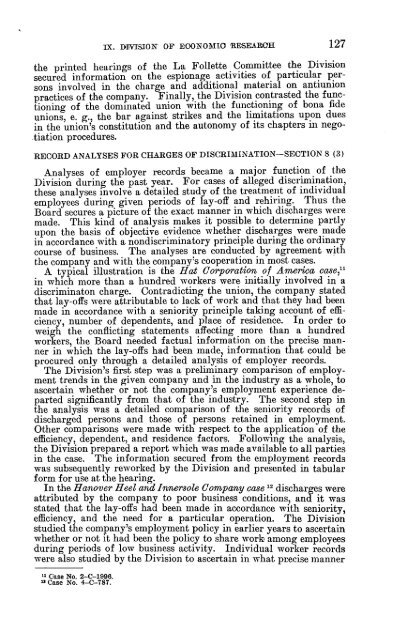NATIONAL LAB RELATIONS BOARD - National Labor Relations ...
NATIONAL LAB RELATIONS BOARD - National Labor Relations ...
NATIONAL LAB RELATIONS BOARD - National Labor Relations ...
You also want an ePaper? Increase the reach of your titles
YUMPU automatically turns print PDFs into web optimized ePapers that Google loves.
IX. DIVISION OF ECONOMIO RESEAROH 127the printed hearings of the La Follette Committee the Divisionsecured information on the espionage activities of particular personsinvolved in the charge and additional material on antiunionpractices of the company. Finally, the Division contrasted the functioningof the dominated union with the functioning of bona fideunions, e. g., the bar against strikes and the limitations upon duesin the union's constitution and the autonomy of its chapters in negotiationprocedures.RECORD ANALYSES FOR CHARGES OF DISCRIMINATION—SECTION 8 (3)Analyses of employer records became a major function of theDivision during the past year. For cases of alleged discrimination,these analyses involve a detailed study of the treatment of individualemployees during given periods of lay-off and rehiring. Thus theBoard secures a picture of the exact manner in which discharges weremade. This kind of analysis makes it possible to determine partlyupon the basis of objective evidence whether discharges were madein accordance with a nondiscriminatory principle during the ordinarycourse of business. The analyses are conducted by agreement withthe company and with the company's cooperation in most cases.A typical illustration is the Hat Corporation of America case,"in which more than a hundred workers were initially involved in adiscriminaton charge. Contradicting the union, the company statedthat lay-offs were attributable to lack of work and that they had beenmade in accordance with a seniority principle taking account of efficiency,number of dependents, and place of residence. In order toweigh the conflicting statements affecting more than a hundredworkers, the Board needed factual information on the precise mannerin which the lay-offs had been made, information that could beprocured only through a detailed analysis of employer records.The Division's first step was a preliminary comparison of employmenttrends in the given company and in the industry as a whole, toascertain whether or not the company's employment experience departedsignificantly from that of the industry. The second step inthe analysis was a detailed comparison of the seniority records ofdischarged persons and those of persons retained in employment.Other comparisons were made with respect to the application of theefficiency, dependent, and residence factors. Following the analysis,the Division prepared a report which was made available to all partiesin the case. The information secured from the employment recordswas subsequently reworked by the Division and presented in tabularform for use at the hearing.In the Hanover Heel and Inner8ole Company case 12 discharges wereattributed by the company to poor business conditions, and it wasstated that the lay-offs had been made in accordance with seniority,efficiency, and the need for a particular operation. The Divisionstudied the company's employment policy in earlier years to ascertainwhether or not it had been the policy to share work among employeesduring periods of low business activity. Individual worker recordswere also studied by the Division to ascertain in what precise manner11 Case No. 2—C-1998.Case No. 4—C-787.
















